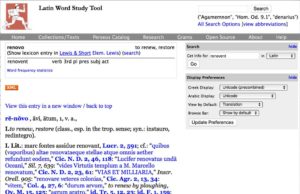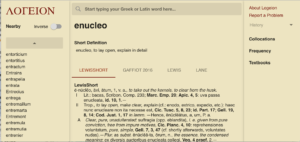Join us as we consider the Latin prayers of the Mass.
Choose the prayers you wish to present from the Latin prayers:
- Collect
- Prayer over the Offerings
- Preface
- Prayer after Communion
Understand your Latin prayers. We shall:
- Draw boxes to show the clausal structure
- Draw trees to show the relations between actions
- Draw a timeline to show the times of actions
- Interpret the function of each clause
- Draw who does what to whom
Intended for students with an intermediate understanding of the Latin language.
At the Pontifical Institute of Liturgy, Sant’Anselmo
Study for 2 academic credits.
OR: Audit to learn without exams, marks, credit.
Dates and Hours
5-16 June 2023, weekdays
8:30 – 11:00 in three daily sessions
8:30-9:15
9:20-10:05
10:15-11:00
Accommodation
Enquire for accommodation at Sant’Anselmo with the Guestmaster click here for his e-mail address.
Instructor:
Daniel McCarthy
email available here
Objectives
At the end of this course the participants will have
- read and understood Latin prayers from the mass including,
- developed an ability to analyse the Latin text of the prayers in several ways,
- developed a more comprehensive understanding of the structure of the Latin language,
- gained greater ease and precision in expressing human thoughts in both Latin and English,
- be prepared to continue their own research in Latin prayers.
Brief description
All our time will be spent considering Latin prayers of the Mass.
Choose the prayers you wish to present from the:
- Collect,
- Prayer over the Offerings,
- Preface,
- Prayer after Communion.
We shall examine the prayers together using a variety of forms of analysis.
Students who have an intermediate understanding of the Latin language will benefit from this course.
Structure of the Course
Participants should have an intermediate familiarity with the different structures of the Latin language found in the prayers, including:
- commands
- participles
- ablative absolute
- uses of the subjunctive
- purpose clauses
- indirect discourse
- gerunds and gerundives.
Students choose the prayers they wish to present from the:
- Collect,
- Prayer over the Offerings,
- Preface,
- Prayer after Communion.
Each person present the chosen prayers using a number of analytical methods including:
- Draw boxes to show the clausal structure,
- Draw trees to show the relations between actions,
- Draw a timeline to show the times of actions,
- Interpret the function of each clause,
- Draw who does what to whom.
We shall have regular recourse to A Latin Dictionary by Lewis and Short, and all participants will need a copy during class.
Presentations of the structure of the Latin language will be made only as needed to understand the prayer under consideration. We shall use the system of studying the Latin language developed by Fr. Reginald Foster, OCD, as presented in the volume Ossa Latinitatis Sola: The Mere Bones of Latin. On occasion we may have recourse to the handbook by Gildersleeve and Lodge
This course is part of the Licentiate program in liturgy at the Pontifical Institute of Liturgy at Sant’Anselmo, Rome. Other qualified people are welcome to enrol and join our reading of Latin prayer texts without enrolling in other courses in liturgy.
Assessment
This course has no final exam, only the regular study and practice of the Latin language. Valuation will be determined on a continuous basis. Participants are expected to participate in our daily encounters and to present prayers on a rotating basis with the other students. The valuation mark indicates active participation in our encounters and making presentations, rather than taking a proficiency exam at the end of our studies.
Assessment is determined by attendance, participation and presentations. Two or more non-excused absences will result in a lower mark at the end of the course.
Participants from other institutes who take this course for credit will receive from the Pontificium Athenaeum Sancti Anselmi ECTS credits for their study of Latin, provided they satisfactorily complete the course requirements.
You may enrol to audit this course which means no exams, no marks, no credits.
Obligatory volumes
- Each participant needs their own copy of the C.T. Lewis – C. Short, A Latin Dictionary, Oxford UP, Oxford – New York 1879, thereafter reprinted. A new and more affordable paper-back edition is available on Amazon. Online versions are helpful but less than fully satisfactory.
- R.T. Foster – D.P. McCarthy, Ossa Latinitatis sola ad mentem Reginaldi rationemque: The Mere Bones of Latin according to the thought and system of Reginald (Latinitatis corpus 1), Catholic University of America Press, Washington DC 2016. Available in print from the publisher or from bookstores in Rome and in digital format directly from the publisher.
Recommended studies
Studies of prayers teach literary analysis and hermeneutics.
- Gildersleeve, B.L, – G. Lodge, Gildersleeve’s Latin Grammar, Bolchazy-Carducci, Wauconda IL 2003, reprint of 31895. This is the standard handbook we consult as needed.
- Appreciating the Collect: An Irenic Methodology, ed. J.G. Leachman – D.P. McCarthy (Documenta Rerum Ecclesiasticarum Instaurata, Liturgiam aestimare : Appreciating the Liturgy 1), St. Michael’s Abbey Press, Farnborough, England 2008.
- Transition in the Easter Vigil: Becoming Christians. Paschali in vigilia Christiani nominis fieri, ed. J.G. Leachman – D.P. McCarthy (Documenta Rerum Ecclesiasticarum Instaurata, Liturgiam aestimare : Appreciating the Liturgy 2), St. Michael’s Abbey Press, Farnborough, England 2011.
- G. Moore, The Collects for Ordinary Time: A Study in the Roman Missal, (Documenta Rerum Ecclesiasticarum Instaurata, Liturgiam aestimare : Appreciating the Liturgy 3), St. Michael’s Abbey Press, Farnborough, England 2017. A good philological and historical study of collects is:
- McCarthy, D.P. – J.G. Leachman – R.T. Foster, Companion to the Missal: Reprints from “The Tablet” of London originally publihsed from 18 March 2006 to 26 November 2011 (Documenta Rerum Ecclesiasticarum Instaurata, Liturgiam aestimare : Appreciating the Liturgy, Varia), private publication 2019. Available in the library at Sant’Anselmo.
- Fernando, R., Deus, Auctor pacis et reconciliationis: A Euchological and liturgico-theological analysis of peace and reconciliation in the Missale Romanum, A dissertation presented in partial fulfillment of the requirements for the Doctor’s Degree (Ph.D.) in Theology (S.T.D.) of the Katholieke Universiteit Leuven Faculty of Theology and Religious Studies, 2018. Available in the library at Sant’Anselmo.
Online resources include the following:
♦ Latin Work Study Tool with the Lewis and Short dictionary available here: Enter an inflected form of your word in the field under the heading “Dictionary Entry Lookup”, located in the column on the right.
♦ LEWIS and SHORT dictionary available here: Enter the dictionary entry for your word in the field under the heading “Dictionary Entry Lookup”, located in the column on the right.
♦ Logeion
Even more Latin dictionaries are available on Logeion, including Lewis and Short. Enter the dictionary entry for your word in the field at the top of this page. If the search produces entries from several different dictionaries, they are listed first and you can choose which one you wish to consult.
Location
Sant’Anselmo
Piazza Cavalieri di Malta, 5
00153 Roma, Italia
See map below.
Materials continued
You may purchase our books from Silvia at the English desk of:
Pauline multimedia
via del Mascherino, 94
00193 Roma
Tel. 06.6872354
Fax: 06.68308093
Silvia’s email
You may also purchase materials at Libreria Sole, located directly across the street from the Gregorian University:
Libreria Sole
Via dei Lucchesi 20
00187 Rome, Italy
Tel.: +39 06 679 06 75

